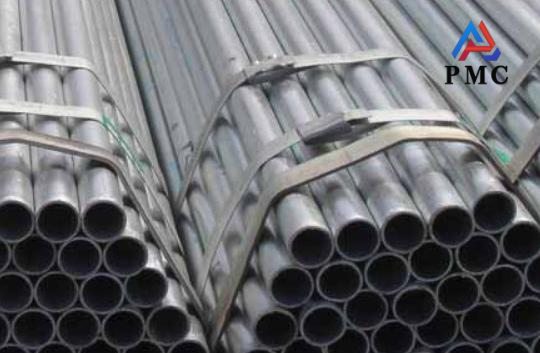
Galvanized ERW Pipe: the All-rounder of Industrial Pipes
What is galvanized erw pipe?
Galvanized erw pipe, that is, Electric Resistance Welded Pipe (Electric Resistance Welded Pipe) is a product that has been galvanized. It uses hot-rolled or cold-rolled steel strip as raw material, which is first curled into a tube by a forming machine, and then the edge of the tube is heated and melted by resistance welding and welded under pressure to make a resistance welded tube, which is finally galvanized. As a common industrial pipe, galvanized erw pipe has both the characteristics of electric resistance welded pipe and the advantages brought by the galvanized layer, and plays an important role in many fields.
Features of galvanized erw pipe
The advantages of galvanized erw pipes are very significant. The welding quality is quite high. The resistance welding technology is used. The weld undergoes a recrystallization process and is consistent with the chemical composition of the parent material. The internal stress is improved through annealing treatment, and the comprehensive mechanical properties are good. The production cost is also low. Its raw material is hot-rolled steel coil, which can realize continuous assembly line operation and has high production efficiency. Its cost advantage is particularly prominent in thin-walled, small-diameter pipes and low-pressure and medium-pressure applications.
At the same time, its weld is not obvious, the heat affected zone of resistance welding is small, the weld is narrow and low, and the inner and outer welds are usually removed after welding, making the inner wall of the pipeline smooth and the fluid resistance small. When transporting liquid or gas, it can improve the transportation efficiency and reduce energy consumption. Moreover, the galvanized layer gives it excellent corrosion resistance, which can effectively resist the erosion of the atmosphere, water and various chemical media, and extend the service life of the pipeline.

Basic parameters of galvanized erw pipe
The common outer diameter range of galvanized ERW pipes is generally 10-720mm, which can meet the needs of different pipe diameters. The wall thickness is in the range of 2.0-30mm, and users can flexibly choose according to actual pressure and strength requirements. In terms of length, it is usually 3-16m, and customization is also supported.
Its implementation standards are diverse, including domestic standards such as GB/T 3091-2015 (welded steel pipe for low-pressure fluid transportation) and GB/T 13793-2016 (straight seam electric welded steel pipe), as well as international standards such as API Spec 5L (Specification for pipeline steel pipe).
Commonly used materials include carbon structural steels such as Q195, Q235, and Q345. These materials have their own characteristics in strength, toughness, and processing performance, and can meet the requirements of pipe performance in different application scenarios.
Production process of galvanized erw pipe
The production process of galvanized ERW pipes is very rigorous. During production, we must first select suitable hot-rolled or cold-rolled steel strips as raw materials according to different usage scenarios and performance requirements, and strictly control their strength and chemical composition to ensure product quality from the source. The coil is then slowly unwound with the help of a spiral accumulator and leveled by a series of rollers to achieve a flat state suitable for subsequent processing.
Next, the flattened steel strip enters the forming stage, where it is gradually bent into a cylindrical shape under the action of a series of forming rollers in preparation for welding. The welding process is crucial. The edges of the formed steel strip are heated to the melting point using high-frequency (HFW) or low-frequency (LFW) current, and are instantly fused under pressure to form a strong weld.
After welding is completed, the steel pipe will pass through a series of rollers for cooling and shaping to ensure that its outer diameter and wall thickness meet the standard requirements, and then be cut into corresponding lengths as required.
Finally, the finished products will be subject to strict quality control. In addition to visual inspection of the appearance for defects, ultrasonic (UT) testing and other means will be used to carefully detect whether there are defects in the welds. Only products that meet all qualified indicators can enter the market.
Wide range of applications
Galvanized erw pipes are highly versatile and excel in a variety of applications.
1. In the field of oil and gas transportation, it has become an ideal choice for long-distance transportation pipelines such as oil and natural gas due to its corrosion resistance, high strength and good sealing performance. It can ensure stable transportation under complex geological and climatic conditions, effectively reduce the risk of pipeline leakage, and ensure the safety of energy transportation.
2. In the field of building structures, it is a commonly used material for building scaffolding, light steel keels and other structures. Its high strength and good corrosion resistance can withstand a certain weight and pressure. During construction and use, it can ensure the stability of the structure and extend the service life of the building.
3. In the field of mechanical manufacturing, galvanized ERW pipes are often used to manufacture various mechanical parts and equipment frames, such as some parts in automobile manufacturing, supporting structures of industrial equipment, etc. They can meet the requirements of machinery for pipe strength, precision and processing performance, and provide guarantee for the stable operation of mechanical equipment.
4. In addition, in the field of heat exchange equipment, its smooth inner wall and good corrosion resistance make it widely used in heat exchangers, condensers and other equipment. It can reduce fluid resistance and improve heat exchange efficiency. At the same time, it resists the corrosion of the medium during the heat exchange process and ensures the long-term stable operation of the equipment.
Read more:Advantages and Disadvantages of Carbon Steel ERW Pipes


